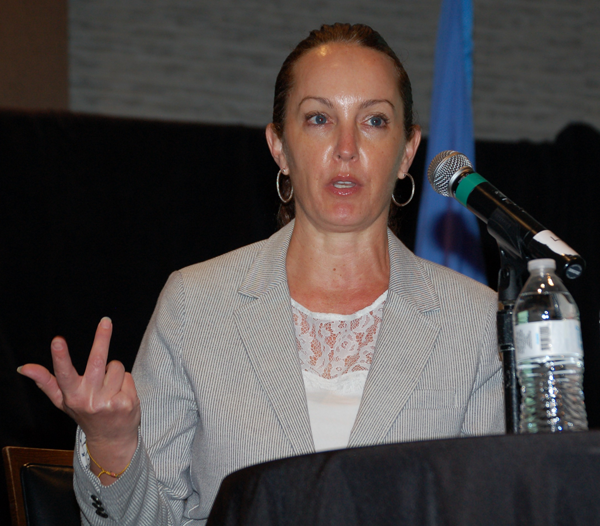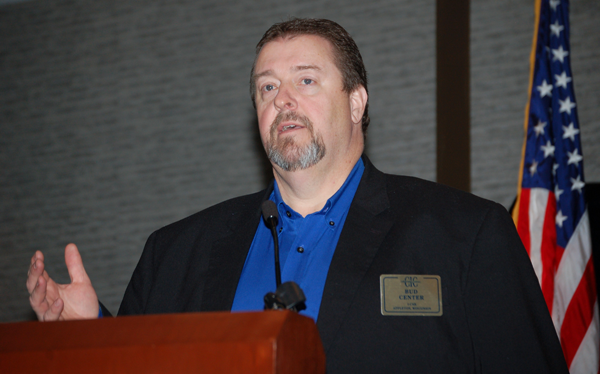It’s not uncommon during discussions within the collision repair industry about the technician shortage for body shop representatives to point to what they see as the inadequate entry-level skills of students completing auto body training programs.
Educators and others speaking at this spring’s Collision Industry Conference (CIC), however, offered their own perspectives on the issue.
“We do not have a recruiting problem. We have a retention problem,” Virginia Oden, a trade and industrial education program specialist with Oklahoma Career Tech, said at the meeting held in Oklahoma City. “How we treat our employees is key. If you don’t provide them with opportunity, they will look elsewhere. They will tell you it’s because of the dollar. But people do not leave a job they love and where they feel appreciated. They leave because of management, period.”
She said she has seen technical education teachers “work hard every day to instill the passion they have for this industry into those students, and then when they get out into the industry, they are treated terribly. They may leave your shop and go down the street to the next shop. But if they’re treated terribly at that shop, they will leave the industry.
"They can get better work and better hours, with less hard labor, working at Amazon," Oden said. "So it’s important once we get them recruited and passionate about what we do, we’ve got to treat them with respect. It’s not about ‘kids today.’ It’s every single person who’s breathing. We all want to be treated with respect.”
Speaking from the floor at CIC, Dane Rounkles of American Honda said he once went to a collision shop in the Southeast to visit a student interning there while completing the Honda Professional Automotive Career Training program at a local school.
“He wasn’t there, and I asked, ‘Did he not show up?’” Rounkles said. “No, he was mowing the shop owner’s yard. When I spoke to the owner of the body shop about this, he said, ‘I had to pay my dues. They’ve got to pay theirs. As long as the school keeps sending people, I never have to mow my yard.’ My point: Do not assume these kids need to do what you and I did.”
Bud Center, chairman of the CIC Talent Pool and Education Committee, said too often he hears shops and schools pointing to the other as the cause of the technician shortage.
“There needs to be more conversation. People need to get on the same page,” Center said.
To that end, the discussion at CIC included panelists sharing ideas about ways to improve the technician shortage. Oden said collision repair and other technical training programs in her state hold summer camps that give fifth and sixth grade students some exposure to the different programs. During eighth grade, students tour technical training programs in their area.
“It’s all about planting seeds. It’s making students and parents and counselors aware of the opportunities that are out there,” Oden said. “At the same time, having done this for a while, the industry tends to want the fruit off the tree. They don’t want to help plant the seed to grow the tree. So they’re not involved in those summer camps and eighth grade visits and sophomore showcases. It’s like anything: If that student has seen your face, they become comfortable with you. You’re building that relationship. You’re starting that investment.”
Amber Alley, manager of Barsotti’s Body & Fender in San Rafael, CA, has spoken at a number of past industry events about the success her shop has seen from its involvement with a local college taking part in a pilot project funded by the Enterprise Rent-A-Car Foundation. The students in the two-year program rotate spending eight weeks at school, then eight weeks working in a shop.

At CIC, Alley said she sees strong evidence of student interest in the trade.
“I’ve done job fairs and that type of thing, and it’s not that people aren’t attracted to the industry,” Alley said. “It’s the presentation of the industry that they get once they come in.”
Too often, she said, shops aren’t willing “to invest in people, and to offer them fair wages and a career path, because they’re scared that someone down the street is going to give them a dollar more. But not everyone is going to make it at your shop. We all have to be willing to take the calculated risk of investing in someone. We can’t have the attitude that they need to prove themselves to us. We need to prove ourselves to them.”
Oden agreed that offering a career path is essential to keep young people in the industry.
“They want to know what those steps are: This is where you are going to start. This is the compensation package, and here’s how you grow that,” Oden said. “I can tell you: Every single student in our career tech programs wants to see that.”
But at the same time, Alley said, the industry needs to have “a serious conversation” about what it will take for shops to pay competitive wages that attract and retain technicians in the industry.

“None of this is going to matter if we can’t keep our doors open, if we can’t charge what the work costs, if you can’t pay the people what they need to earn to stay in the industry,” she said. “That needs to be a priority, having that conversation. We need to be big boys and girls about it, and be really serious…None of this is going to get solved unless we can pay people what their value is.”
Center said when he asks shop owners what they are personally doing to help address the technician shortage and if they are involved with local schools, they often say they don’t have the time.
“If you don’t have time as the owner or manager of a business in this industry to help solve this problem, who is going to do it? If you don’t have time, designate someone on your team to take that responsibility, and get this stuff done,” Center said. “Somebody has to take the lead.”











John Yoswick